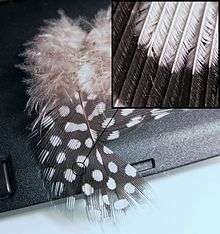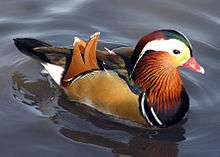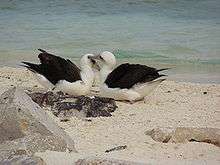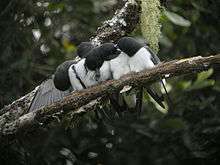Preening (bird)
Preening is a maintenance behaviour found in birds that involves the use of the beak to position feathers, interlock feather barbules that have become separated, clean plumage, and keep ectoparasites in check. Though primarily an individual function, preening can also be a social activity involving two or more birds, which is known as allopreening.
-6.jpg)
Etymology
The use of the word preen to mean the tidying of a bird's feathers dates from Late Middle English. It appears to be a variant of the word prune; one now-obsolete definition of prune meant "anoint", based on the Latin ungere, which had the same meaning. This usage was combined with the Scottish and northern English dialect preen meaning "pierce" or "pin", due to the "pricking" action of the bird's beak during preening.[1]
Importance

Displaced feathers can cause birds considerable trouble; such feathers might become damaged, could interrupt the smooth flow of air over a flying bird, or might allow the bird's body heat to escape. Preening allows a bird to reposition such displaced feathers. There is evidence that filoplumes, specialized feathers buried under a bird's outer covering of contour feathers, help to signal when contour feathers have been displaced.[2] Preening also enables birds to remove dirt and parasites from their plumage,[3] and assists in the waterproofing of feathers.[4] During moult, birds remove the sheaths from around their emerging pin feathers while preening.[5]
Because feathers are critical to a bird's survival—contributing as they do to insulation, waterproofing and aerodynamic flight — birds spend a great deal of time maintaining them.[5] Studies on multiple species have shown that birds spend an average of more than 9% of each day on maintenance behaviours, with more than 92% of that time spent preening.[6] However, this number can be significantly higher. One study found that some gull species spend 15% of their daylight hours preening during the breeding season, for example,[7] and another showed common loons spend upwards of 25% of their day preening.[6] In most of the studied species where the bird's sex could be determined in the field, males spent more time preening than females, though this was reversed in ducks.[6]
Preening action
A bird's plumage is primarily made up of two feather types: firm vaned or pennaceous feathers on the surface, with softer down feathers underneath. Both feather types have a central shaft with narrower barbs branching from that shaft. Pennaceous feathers also have much smaller barbules branching from the entire length of each barb; these barbules have tiny hooks along their length, which interlock with the hooks of neighboring barbules. Preening may involve two kinds of bill actions: nibbling (or mandibulating) while working the feather from base to tip, or stroking with the bill either open or closed. In grebes, this is done more vigorously with an open bill and is termed "stropping". In penguins, the head is also used in a motion referred to as "wiping". Some birds will also use their feet in an action termed as scratch-preening which is usually applied to the head. Some species (including nightjars, herons, frigatebirds, owls and pratincoles)[8] have comb-like serrations on the claw (a pectinate claw) of the middle toe which may aid in scratch preening. While some species use the leg over the lowered wing to reach the head, others extend the leg more directly between the wing and the body.[9][10] In general, these activities take place while the bird is either perched, on the ground, or swimming, but some of the more aerial species (including swallows, terns and albatrosses) preen on the wing.[11] Many birds have a slight overhang at the tip of their upper mandible. Experiments suggest that this allows birds to apply shearing forces that kill the flattened feather lice; the removal of the bill tip caused an increase in feather lice due to ineffective preening.[12][13]
Preening is often done in association with other maintenance behaviours, including bathing, dusting, sunning, oiling or anting, and can either precede or follow these other behaviours.[14]
Preen oil
Because fully-grown feathers are essentially dead structures, it is vital that birds have some way to protect and lubricate them. To facilitate this, many species have a preen or uropygial gland, which opens above the base of the tail feathers and secretes a substance containing fatty acids, water, and waxes. The bird gathers this substance on its bill and applies it to its feathers.[15] The gland is generally larger (in relation to body size) in waterbirds, including terns, grebes and petrels, but studies have found no clear correlation between the size of a bird's gland and the exposure to water that its lifestyle dictates.[16]
Preen oil plays a role in reducing the presence of parasitic organisms, such as feather-degrading bacteria, lice and fungi, on a bird's feathers.[15] For example, one study showed that the presence of the bacteria Enterococcus faecalis in the preen oil of hoopoes inhibited the growth of the bacteria Bacillus licheniformis, a species which breaks down keratin, the main component of feathers. Enterococcus faecalis did this by releasing bacteriocin.[17] Other studies have shown that removing or restricting access to the uropygial gland typically results in a higher bacterial parasite load on the plumage, though not necessarily of feather-degrading bacterial species.[18][19] Preen oil may also play a part in protecting at least some species from some internal parasites; a study of the incidence of avian malaria in house sparrows found that uninfected birds had larger uropygial glands and higher antimicrobial activity in those glands than infected birds did.[20]
Preen oil also helps to maintain the waterproofing of a bird's plumage. Though the oil does not provide any direct waterproofing agent, it helps to extend the life of the feather — including the microscopic structures (the barbs and barbules) which interlock to create the waterproof barrier.[4]
While most species have a preen gland, the structure is missing in the ratites (emu, ostrich, cassowary) and some neognath birds, including bustards, a few parrots and pigeons. Some species employ powder down feathers which continually break down into a fine dust that the birds apply to their contour feathers while preening.[21]
Secondary functions

Preening may help to send sexual signals to potential mates because plumage colouration (which can be altered by the act of preening) can reliably reflect the health or "quality" of its bearer.[22] In some species, preen oil is used to cosmetically colour the plumage. During the breeding season, for example, the preen oil of the great white pelican becomes red-orange, imparting a pink flush to the bird's plumage. The yellow feathers of the great hornbill are also cosmetically coloured during preening.[22] The preen oil of the Bohemian waxwing increases the UV reflectance of its feathers.[23] Ritualized preening is used in courtship displays by a number of species, particularly ducks;[24] such preening is typically designed to draw attention to a modified structure (such as the sail-shaped secondaries of the drake Mandarin duck) or distinctive color (such as the speculum) on the bird.[25]
Preening may also be performed as a displacement activity. In some cases, it is done in place of another activity that birds are strongly motivated, but unable, to do. In one study, black-headed gulls which were prevented from incubating a full clutch of eggs (by the removal of eggs from their nest) responded by preening and nest building—both displacement activities. When all three eggs in their regular clutch were removed, the gulls showed a significant increase in the amount of time they spent preening.[26] The conflict between two incompatible drives, such as incubating and escape, can also lead a bird to engage in displacement activities. Nesting Sandwich and common terns preen when they have been alarmed by a potential predator or when they have had an aggressive encounter with a neighboring bird, for instance.[27] Fighting European starlings will break off their battles to preen.[28]
Allopreening

Although preening is primarily an individual behaviour, some species indulge in allopreening, with one individual preening another.[9] It is not particularly common among birds,[29] though species from at least 43 families are known to engage in the mutual activity.[30] Most allopreening activity concentrates on the head and neck, with a lesser amount directed towards the breast and mantle and an even smaller percentage applied to the flanks. A few species are also known to allopreen other areas, including rump, tail, belly and underwing.[31]
A number of hypotheses have been advanced to explain the behavior: that it assists in effective grooming, that it assists in recognition of individuals (mates or potential sexual partners), and that it assists in social communication, reducing or redirecting potential aggressive tendencies.[30] These functions are not mutually exclusive.[32] Evidence suggests that different species may participate for different reasons, and that those reasons may change depending on the season and the individuals involved.[30] In most cases, allopreening involves members of the same species, although some cases of interspecific allopreening are known; the vast majority of these involve icterids, though at least one instance of mutual grooming between a black vulture and a crested caracara has been documented.[33] Birds seeking allopreening adopt specific, ritualised postures to signal so; they may fluff their feathers out, for example, or put their heads down.[29]
There is some evidence that allopreening may help to keep in good condition those feathers that a bird cannot easily reach by itself; allopreening activities tend to focus on the head and neck, for example.[34][35] It may also help to remove ectoparasites from those hard-to-reach areas. Allopreening is most common among species that are regularly in close physical contact due to flocking or social behaviours,[29] and such contact allows for easier transfer of ectoparasites between individuals.[36] In one study, Macaroni penguins that frequently allopreened had significantly fewer ticks on their heads and necks than those that did not.[37] Green wood hoopoes, a flocking species with a complex hierarchy, show similar frequencies of initiating and reciprocating allopreening of the head and neck regardless of social status, time of year or group size, which suggests that such activity is primarily related to feather hygiene.[32]

Most allopreening is done between the two members of a mated pair,[9] and the activity appears to play an important role in strengthening and maintaining pair bonds. It is more common in species where both parents help to raise the offspring and correlates with an increased likelihood that partners will remain together for successive breeding seasons.[36] Allopreening often features as part of the "greeting ceremony" between the members of a pair in species such as albatrosses and penguins, where partners may be separated for a relatively long period of time, and is far more common among sexually monomorphic species (that is, species where the sexes look outwardly similar). It appears to inhibit or sublimate aggression, as it is typically the dominant bird that initiates the behaviour.[31]
Allopreening also appears to reduce the incidence of conflict between members of some colonially living or colonially nesting species. For example, neighboring black guillemots that engaged in allopreening were much less likely to fight. Since fights often lead to eggs or chicks being knocked off breeding cliffs, fewer fights led to greater breeding success for allopreening neighbors.[38] Among social flocks of green wood hoopoes, rates of body allopreening (that is, allopreening of another bird's body rather than head and neck) increased with group size. Evidence suggests this type of allopreening reduces social tension, and thus plays an important role in group cohesion. More dominant birds received far more body allopreening services than did lower-ranked birds, and lower-ranked birds initiated far more body allopreening bouts than did their higher-ranked flock mates. Body allopreening was only reciprocal when done with between members of a mated pair; otherwise, the dominant bird reciprocated in fewer than 10% of the instances.[32] Among caged birds, confining a bird with an incompatible or very dominant cage mate can lead to excessive allopreening, which can result in feather plucking or injury.[39]
References
- "Preen". Oxford English Living Dictionary. Oxford University Press. Retrieved 6 August 2017.
- Necker, Reinhold (May 1985). "Observations on the function of a slowly-adapting mechanoreceptor associated with filoplumes in the feathered skin of pigeons". Journal of Comparative Physiology A. 156 (3): 391–394. doi:10.1007/BF00610731.
- Moss, Stephen (2015). Understanding Bird Behaviour. London, UK: Bloomsbury. p. 71. ISBN 978-1-4729-1206-0.
- Lovette, Irby C.; Fitzpatrick, John W., eds. (2016). Handbook of Bird Biology (3rd ed.). Oxford, UK: John Wiley & Sons. p. 129. ISBN 978-1-118-29105-4.
- Elphick, Chris; Dunning, Jr., John B. (2001). "Behaviour". In Elphick, Chris; Dunning, Jr., John B.; Sibley, David (eds.). The Sibley guide to Bird Life & Behaviour. London: Christopher Helm. pp. 57–59. ISBN 978-0713662504.
- Cotgreave1, Peter; Clayton, Dale H. (1994). "Comparative Analysis of Time Spent Grooming By Birds in Relation To Parasite Load" (PDF). Behaviour. 131 (3): 171–187. doi:10.1163/156853994X00424. ISSN 0005-7959.
- Delius, J. D. (May 1988). "Preening and Associated Comfort Behavior in Birds" (PDF). Annals of the New York Academy of Sciences. 525 (1 Neural Mechan): 40–55. Bibcode:1988NYASA.525...40D. doi:10.1111/j.1749-6632.1988.tb38594.x. PMID 2839072.
- Stettenheim, Peter R. (August 2000). "The Integumentary Morphology of Modern Birds—An Overview". American Zoologist. 40 (4): 461–477. CiteSeerX 10.1.1.559.1172. doi:10.1668/0003-1569(2000)040[0461:timomb]2.0.co;2. ISSN 0003-1569.
- Campbell, Bruce; Lack, Elizabeth, eds. (1985). A Dictionary of Birds. Carlton, UK: T and A D Poyser. pp. 102–103. ISBN 978-0-85661-039-4.
- Nice, Margaret M.; Schantz, W.E. (1959). "Head-Scratching Movements in Birds" (PDF). The Auk. 76 (3): 339–342. doi:10.2307/4081811. JSTOR 4081811.
- Goodwin, Robert E. (October 1959). "Records of Flight Preening and Related Aerial Activities in Birds, Particularly the Black Tern" (PDF). The Auk. 76 (4): 521–523. doi:10.2307/4082320. JSTOR 4082320.
- Clayton, Dale H.; Moyer, Brett R.; Bush, Sarah E.; Jones, Tony G.; Gardiner, David W.; Rhodes, Barry B. & Goller, Franz (2005). "Adaptive significance of avian beak morphology for ectoparasite control". Proceedings of the Royal Society B: Biological Sciences. 272 (1565): 811–817. doi:10.1098/rspb.2004.3036. PMC 1599863. PMID 15888414.
- Bush, Sarah E.; Clayton, Dale H. (2018). "Anti-parasite behaviour of birds". Philosophical Transactions of the Royal Society B: Biological Sciences. 373 (1751): 20170196. doi:10.1098/rstb.2017.0196. PMC 6000146. PMID 29866911.
- Carnaby, Trevor (2008). Beat about the Bush: Birds. Johannesburg, South Africa: Jacana Media. p. 358. ISBN 978-1-77009-241-9.
- Gill, Frank B. (2007). Ornithology (3 ed.). New York NY, US: Freeman. pp. 89–102. ISBN 978-0-7167-4983-7.
- Montalti, Diego; Salibián, Alfredo (2000). "Uropygial Gland Size and Avian Habitat" (PDF). Ornitologia Neotropical. 11: 297–306.
- Ruiz-Rodríguez, M.; Valdivia, E.; Soler, Juan J.; Martín-Vivaldi, M.; Martín-Platero, A. M.; Martínez-Bueno, M. (2009). "Symbiotic bacteria living in the hoopoe's uropygial gland prevent feather degradation" (PDF). Journal of Experimental Biology. 212 (22): 3621–3626. doi:10.1242/jeb.031336. ISSN 0022-0949. PMID 19880722.
- Czirják, Gábor Árpád; Pap, Péter László; Vágási, Csongor István; Giraudeau, Mathieu; Mureşan, Cosmin; Mirleau, Pascal; Heeb, Philipp (February 2013). "Preen gland removal increases plumage bacterial load but not that of feather-degrading bacteria". Naturwissenschaften. 100 (2): 145–151. Bibcode:2013NW....100..145C. doi:10.1007/s00114-012-1005-2. ISSN 1432-1904. PMID 23288399.
- Giraudeau, M.; Czirják, G.Á.; Duval, C.; Bretagnolle, V.; Gutierrez, C.; Guillon, N.; Heeb, P. (January 2013). "Effect of preen oil on plumage bacteria: An experimental test with the mallard". Behavioural Processes. 92: 1–5. doi:10.1016/j.beproc.2012.08.001. PMID 22940115.
- Magallanes, Sergio; Pape Møller, Anders; García-Longoria, Luz; de Lope, Florentino; Marzal, Alfonso (2016). "Volume and antimicrobial activity of secretions of the uropygial gland are correlated with malaria infection in house sparrows". Parasites & Vectors. 9: 232. doi:10.1186/s13071-016-1512-7. PMC 4845389. PMID 27114098.
- Wetmore, Alexander (1920). "The Function of Powder Downs in Herons" (PDF). The Condor. 22 (5): 168–170. doi:10.2307/1362391. JSTOR 1362391.
- Delhey, Kaspar; Peters, Anne; Kempenaers, Bart (2007-01-01). "Cosmetic Coloration in Birds: Occurrence, Function, and Evolution". The American Naturalist. 169 (S1): S145–S158. doi:10.1086/510095. ISSN 0003-0147. PMID 19426089.
- Pérez-Rodríguez, Lorenzo; Mougeot, Francois; Bortolotti, Gary R. (2011-07-01). "The effects of preen oils and soiling on the UV–visible reflectance of carotenoid-pigmented feathers". Behavioral Ecology and Sociobiology. 65 (7): 1425–1435. doi:10.1007/s00265-011-1153-y. hdl:10261/143995. ISSN 0340-5443.
- Tinbergen, N. (March 1952). ""Derived" Activities; Their Causation, Biological Significance, Origin, and Emancipation During Evolution". The Quarterly Review of Biology. 27 (1): 1–32. doi:10.1086/398642. PMID 14930222.
- Huxley, Julian; Hardy, A. C.; Ford, E. B., eds. (1954). Evolution as a Process (PDF). London, UK: George Allan & Unwin. p. 242.
- Moynihan, M. (January 1953). "Some Displacement Activities of the Black-headed Gull". Behaviour. 5 (1): 58–80. doi:10.1163/156853953X00041. ISSN 0005-7959. JSTOR 4532768.
- Van Iersel, J. J. A.; Bol, A. C. Angela (January 1958). "Preening of Two Tern Species. a Study On Displacement Activities". Behaviour. 13 (1): 1–87. doi:10.1163/156853958x00037. ISSN 1568-539X. JSTOR 4532894.
- Mitchell, J. C. (18 May 1968). "Dermatological aspects of displacement activity: attention to the body surface as a substitute for "fight or flight"". Canadian Medical Association Journal. 98 (20): 962–964. PMC 1924139. PMID 5657176.
- Wilson, Edward O. (2000) [1975]. Sociobiology: The New Synthesis. Cambridge, MA, US: Harvard University Press. pp. 208–209. ISBN 978-0-674-00089-6.
- Forsman, Eric D.; Wight, Howard M. (July 1979). "Allopreening in Owls: What Are Its Functions?" (PDF). The Auk. 96 (3): 525–531. JSTOR 4085549.
- Harrison, C. J. O. (July 1965). "Allopreening as Agonistic Behaviour". Behaviour. 24 (3): 161–208. doi:10.1163/156853965x00011. ISSN 1568-539X. JSTOR 4533105.
- Radford, Andrew N.; Du Plessis, Morné A. (December 2006). "Dual Function of Allopreening in the Cooperatively Breeding Green Woodhoopoe, Phoeniculus purpureus". Behavioral Ecology and Sociobiology. 61 (2): 221–230. doi:10.1007/s00265-006-0253-6. JSTOR 25511576.
- Ng, David; Jasperson, Bruce D. (May 1984). "Interspecific Allopreening between Crested Caracara and Black Vulture" (PDF). The Condor. 86 (2): 214–215. doi:10.2307/1367047. JSTOR 1367047.
- Loon, Rael; Loon, Hélène (2005). Birds: The Inside Story. Cape Town, South Africa: Struik. p. 36. ISBN 978-1-77007-151-3.
- Olsen, Penny; Joseph, Leo (2011). Stray Feathers: Reflections on the Structure, Behaviour and Evolution of Birds. Collingwood, VIC, Australia: CSIRO. p. 249. ISBN 978-0-643-09493-2.
- Kenny, Elspeth; Birkhead, Tim R. & Green, Jonathan P. (July–August 2017). "Allopreening in birds is associated with parental cooperation over offspring care and stable pair bonds across years". Behavioral Ecology. 28 (4): 1142–1148. doi:10.1093/beheco/arx078. PMC 5873249. PMID 29622926.
- Deeming, D. Charles; Reynolds, S. James, eds. (2015). Nests, Eggs, and Incubation: New ideas about avian reproduction. Oxford, UK: Oxford University Press. p. 94. ISBN 978-0-19-871866-6.
- Lewis, Sue; Roberts, Gilbert; Harris, Mike P.; Prigmore, Carina; Wanless, Sarah (August 2007). "Fitness increases with partner and neighbour allopreening". Biological Letters. 3 (4): 386–389. doi:10.1098/rsbl.2007.0258. PMC 2390679. PMID 17550875.
- Coles, Brian H., ed. (2007). Essentials of Avian Medicine and Surgery (3rd ed.). Oxford, UK: Blackwood Publishing Ltd. p. 46. ISBN 978-1-4051-5755-1.